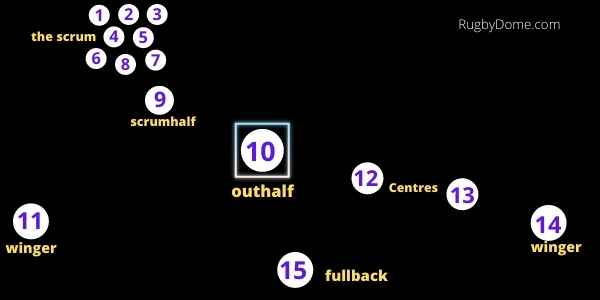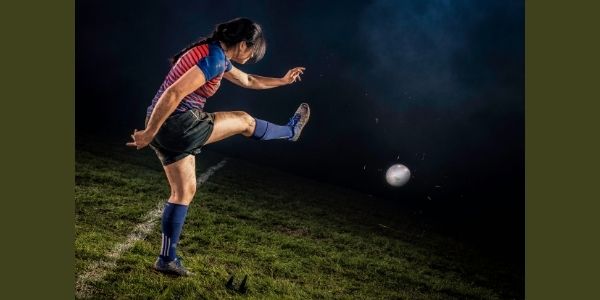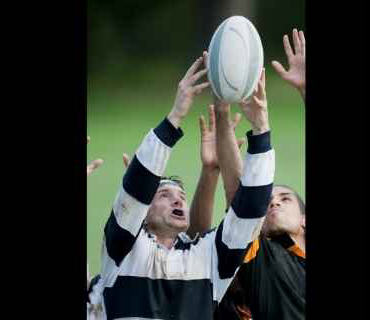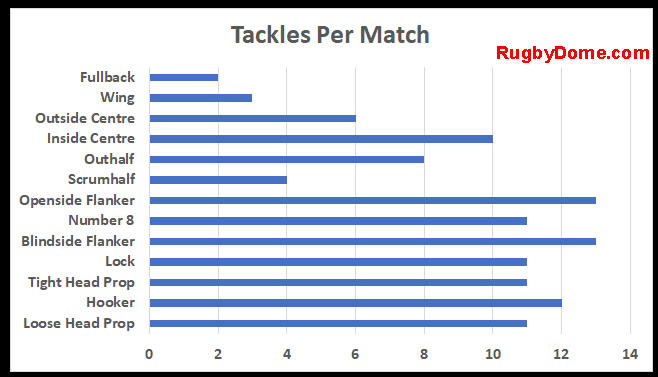There is one outhalf in the starting fifteen players on a rugby union team. The outhalf wears the number ten jersey.
The position is also called flyhalf and standoff in Europe. In the southern hemisphere, you may hear it called the first five-eighth. I tend to use outhalf and flyhalf interchangeably.
This article looks at the position and role of the outhalf.
What Does The Outhalf Do?
Outhalves are typically positioned between the forwards and the outside backs and receive the ball from the scrum-half.
This diagram shows a typical formation at the start of a scrum.

The outhalf is the main playmaker on a rugby team. They lead the backline and move the ball to wider players through short and long passes.
Outhalves are also the primary kickers. They usually take restarts, kick penalties, and kick for territory.
Flyhalf As Playmaker
What does it mean to be a playmaker? The term simply refers to initiating and controlling the attacking play.
Outhalves often choose the attacking play launched from rucks and scrums. They shout the code for the move to the scrumhalf and wider players.
Although scrum halves may also be playmakers, they are often crouched behind the ruck and unable to see the bigger picture.
Outhalves take the “sergeant-major” role because they stand away from rucks and are constantly scanning the field for opportunities.
Playmakers use their passing skills to direct the flow. The goal is to put their team into situations where they can find space between opposition defenders.
They may throw a long pass out to the backs for a wide attacking move. Alternatively, they can “keep play tight” by giving short passes to a nearby forward or inside center.
Primary Kicker On The Team

Aside from passing, the flyhalf can also opt to kick the ball forward to gain territory and put pressure on the opposition back three players (the wingers and fullback).
There are two main kicking strategies:
- kicking to put the ball off the field
- kicking to a position where a teammate can compete to win the ball
Kicking for touch
“Kicking for touch” means kicking the ball off the field to gain territory by forcing the opposition to retreat for a lineout.
This may seem straightforward, but the laws of rugby make it a specialist skill.
Depending on where the kicker is on the field, they must ensure that the ball bounces before it goes over the sideline.
Otherwise, the opposition gets a lineout from where the kicker was standing. That is a big mistake!
The flyhalf isn’t the only player who takes responsibility for kicking for touch. All the backs must be capable of doing so.
In particular, fullbacks will often step in to make a tactical kick. Many fullbacks are converted flyhalves, which can be a great advantage for a team’s kicking strategy.
Up And Unders
The technique of kicking an “up and under” is to launch a long high kick that gives enough time for an outside back to race forward to compete to catch it.
This is also a skill that takes practice to master under pressure. If the flyhalf kicks the ball too long, it’s just handing easy possession to the opposition.
There are some flyhalves who do it all: they kick the ball high, race forward, and jump and catch the ball themselves.
We show an example in our article on rugby players catching their own kicks.

Kicking for points
Most teams hand the role for kicking penalties and try conversions to their outhalf.
This isn’t always the case. Some famous fullbacks have been the primary points kicker for their team. Welsh international Leigh Halfpenny is one recent example.
Kick, Pass, Or Run
When outhalves receive the ball, they have three options: kick, pass, or run.
We’ve already discussed kicking and passing. Let’s end with running.
In this scenario, the outhalf holds onto the ball and looks to make a break.
A fast and agile outhalf can be devastating when they find a gap between the opposition flankers and defending backs.
In recent years, Beauden Barrett terrorized defenders with searing pace as he scored tries for fun for the All Blacks.
But coaches often place more value on a less exciting ten who can control a game with effective kicking.
Fans tend to favor the flyhalves who light up a match with incisive breaks.
Defending At Ten
Our graph of the number of tackles by position in the 2021 Six Nations shows that outhalves make the second most tackles of all the backs with an average of eight per match.

This is because they are positioned closer than the other backs to the opposition ball.
There’s nothing that a backrow loves more than picking up the ball from the back of a ruck and charging at the number ten.
This means that outhalves must be able to make strong tackles. They are ideally helped by their own flanker.
Some teams choose to switch a small ten to the wing on defensive plays and shift the rest of the backline in by one position. That leaves a burly inside centre defending the ten channel.
Half Backs
Outhalves and scrum halves are collectively called half backs.
They work together to direct the team in attacking play.
In some countries, scrum halves take on more of the playmaking role. That traditionally includes France and South Africa.
In most rugby countries, the outhalf tends to call the shots in open play.
However, they rely on the scrum half to direct the forwards when the ball is kept close to rucks for multiple phases.
You can learn more in our article on the role of the scrum half in rugby.
More About Outhalves
Who was the best number ten of all time? Check out our article on the greatest outhalves in rugby. We limit our choices to the last forty years, but these are modern greats.
Our general overview of rugby positions and numbers has links to in-depth articles for each playing position.